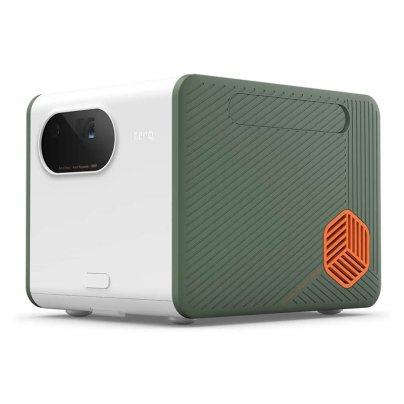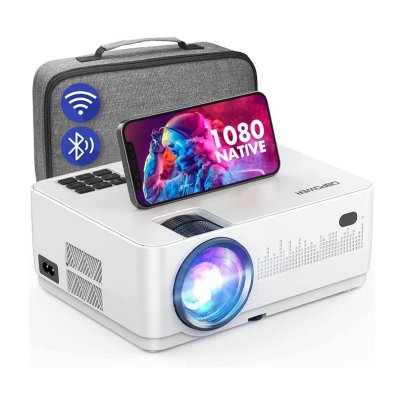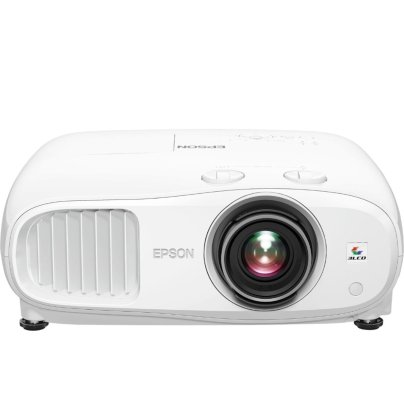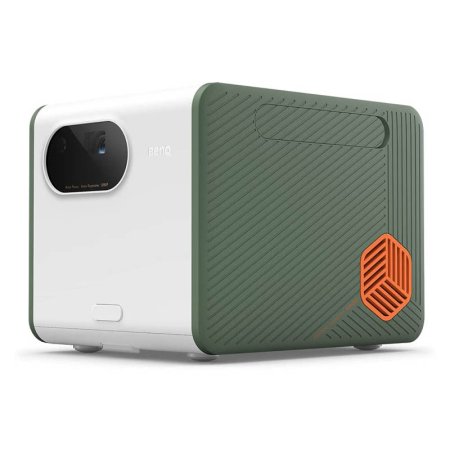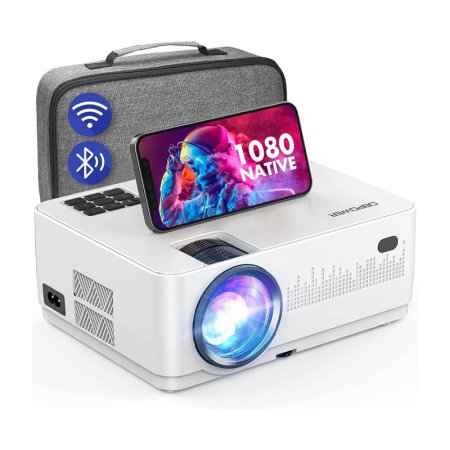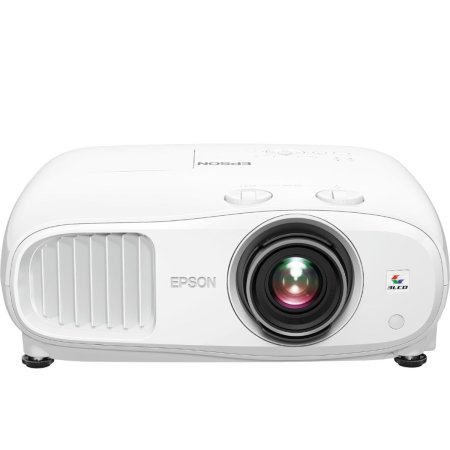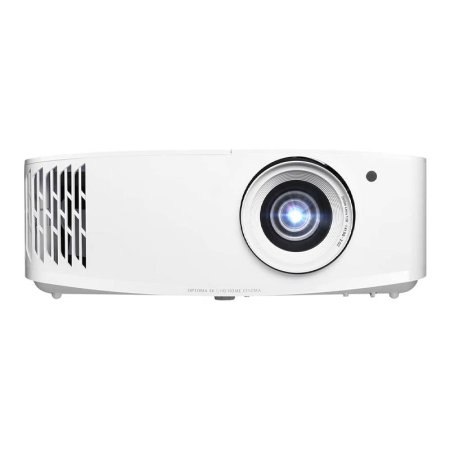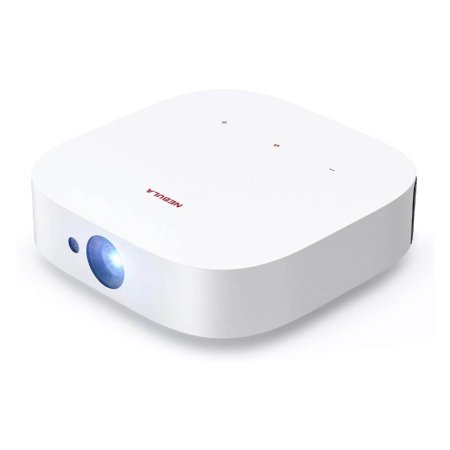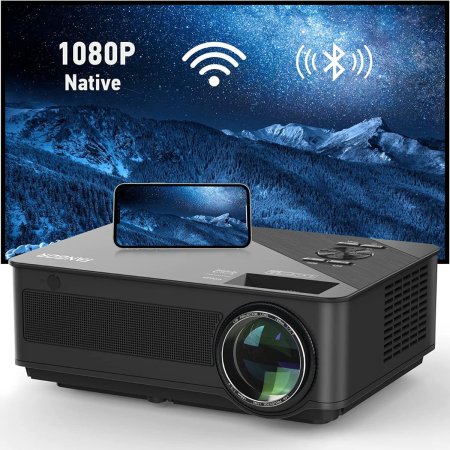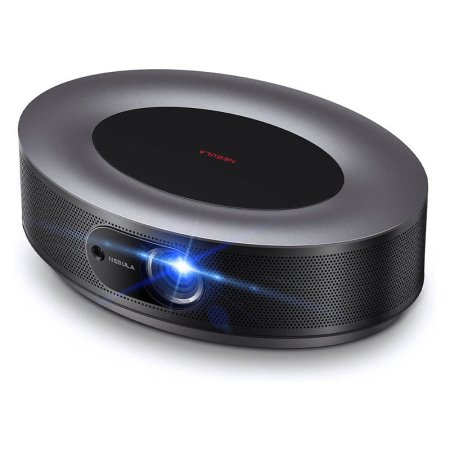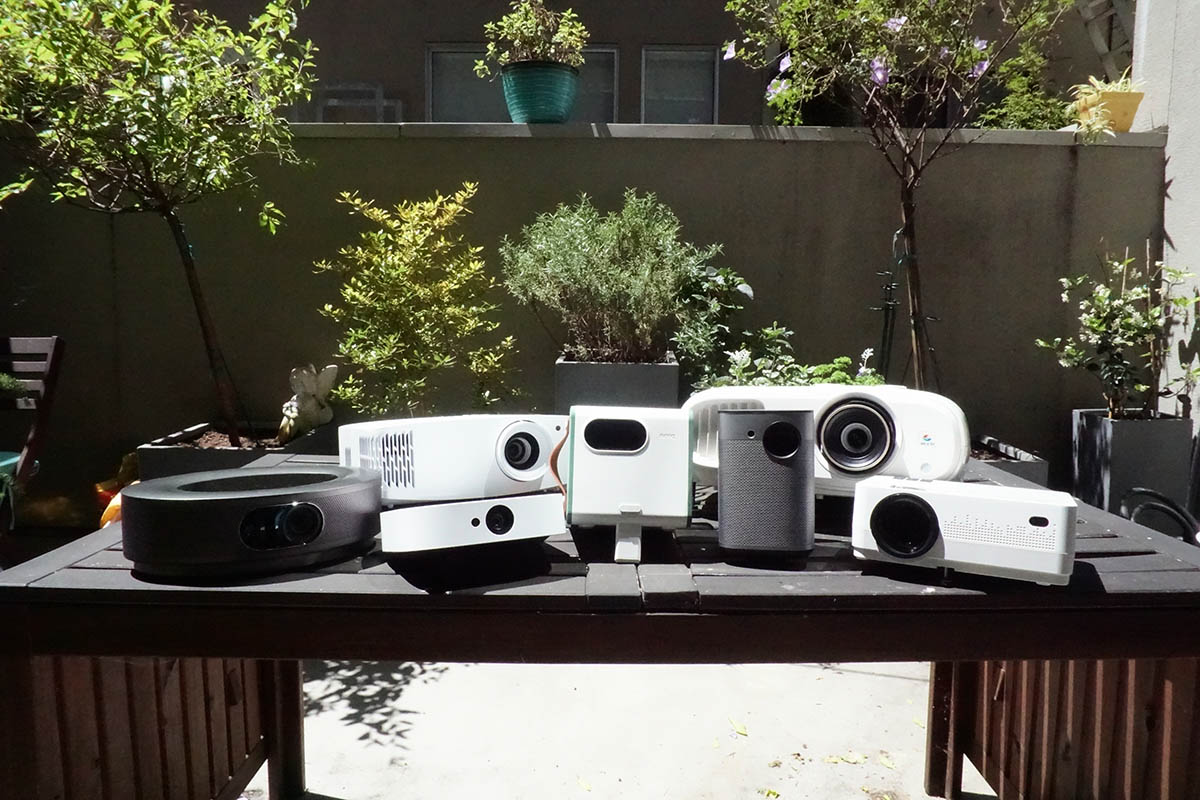
We may earn revenue from the products available on this page and participate in affiliate programs. Learn More ›
An outdoor projector offers a wonderful way to enjoy an entertaining evening with family and friends. Before hosting another backyard movie night, users should consider upgrading their current model to one of the best outdoor projectors on our list, which have all been hands-on tested.
Though similar to their indoor classroom-office counterparts, projectors for outdoor movies are significantly brighter, have a clearer picture, and can be used on larger screens than models intended for slideshow presentations.
Outdoor projectors are becoming increasingly popular, and there are many to choose from with varying prices and specifications. We tested the following models extensively for ease of setup and operation, included features, audio quality, and picture quality in both low- and bright-light conditions.
Our top pick is the BenQ GS50 Portable Projector. We chose it as the best overall because of its 500-lumen brightness, 1080p HD picture resolution, 16:9 aspect ratio, and its smart connectivity or remote-controlled operation. We also appreciate that it’s lightweight and portable.
Our top picks have all the features shoppers will want to consider when looking for the best backyard projector for their needs.
- BEST OVERALL: BenQ GS50 Portable Projector
- BEST BANG FOR THE BUCK: DBPower L23 9000L Native 1080P WiFi Video Projector
- UPGRADE PICK: Epson Home Cinema 3800 4K PRO-UHD Projector
- BEST FOR GAMING: Optoma UHD38 4K Home Theater and Gaming Projector
- BEST PORTABLE: Anker Nebula Solar Portable Projector
- BEST BLUETOOTH: Fangor Native 1080P WiFi/Bluetooth Projector
- ALSO CONSIDER: Anker Nebula Cosmos Projector
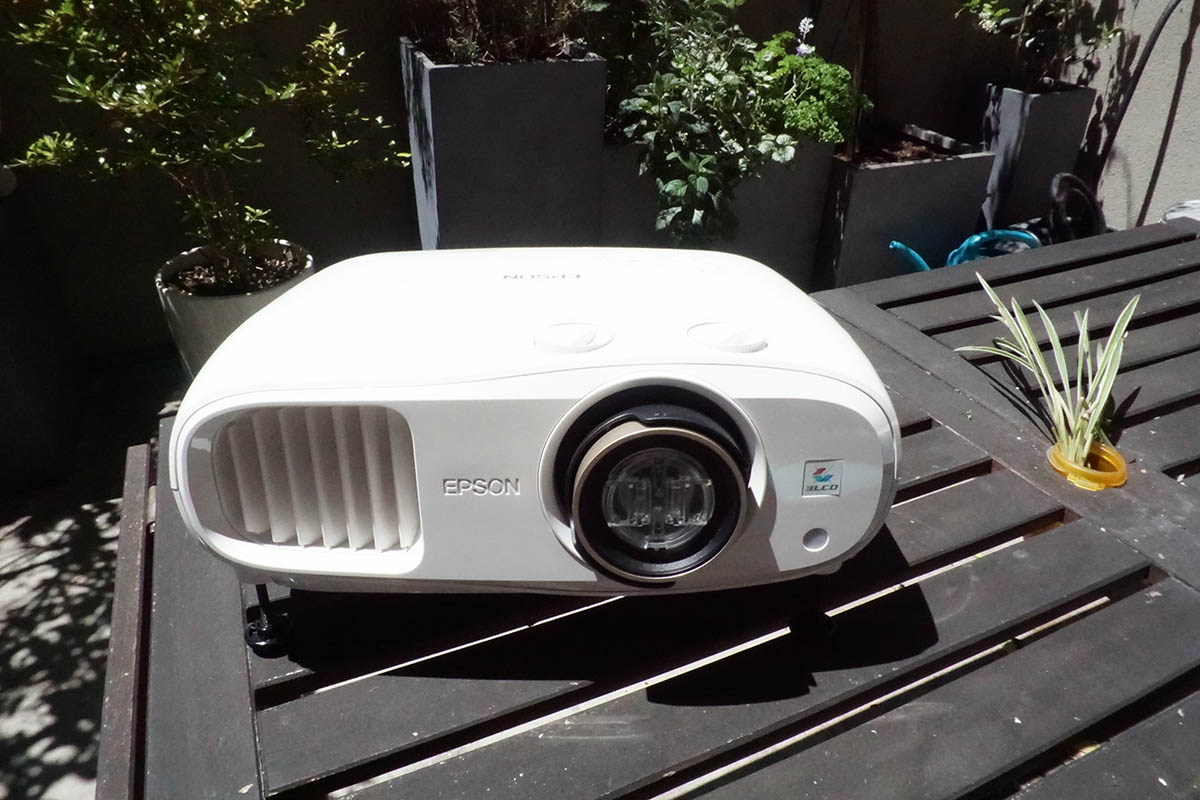
How We Tested the Best Outdoor Projectors
To help shoppers find the best outdoor projectors, we put every model through extensive, real-world use. We evaluated each one on its setup, including the physical positioning and the setup of internal functions, like Wi-Fi, Bluetooth, and projector settings; picture and audio quality; brightness performance during the day, dusk, and night conditions; user-interface operation; and any additional features included in each projector.
We tested every unit with a variety of demanding materials, including big-budget action movies, 3D animated movies, and sporting events. For a consistent reference, among all the other material, we made sure to watch and evaluate clips on every projector from “Avatar” and the IMAX-enhanced “Avengers: Endgame” on Disney+.
Our Top Picks
All of the projectors we tested rank high for technical specifications, price, and performance but vary regarding ease of setup and operation, included features, audio quality, and picture quality in both low- and bright-light conditions. Here are the best outdoor movie projector options for backyard entertainment.
Best Overall
BenQ GS50 Portable Projector
Pros
- Beautiful picture with sharp details, vibrant colors, and deep contrast
- Loud, high-quality audio with Bluetooth-speaker capability
- Comprehensive design for convenient portability
- Super-accurate autofocus accessible from remote-control button
Cons
- Short battery life of 2.5 hours under restricted conditions
- Netflix playback only over HDMI or with desktop browser Chromecast
- Moderate brightness for daytime use
Product Specs
- Brightness/contrast: 500 American National Standards Institute (ANSI) lumens/100,000:1
- Picture: 1080p (1920 x 1080) full HD; 16:9 aspect ratio
- Connectivity: Built-in Android TV (including “Hey Google” voice control), Apple AirPlay, Bluetooth, Chromecast, HDMI, USB-A for thumb drives, USB-C for Displayport, Wi-Fi
The BenQ GS50 1080-pixel (p) Outdoor Projector has it all: fantastic image quality, built-in Android TV streaming apps, high-quality audio, ample wireless and wired connectivity, and the size and durability for truly portable use.
This 5-pound cube-shaped mini outdoor projector was built with IPX2 splash protection and drop protection from 2.3 feet high, and it comes with a sturdy zip case for the BenQ GS50 and all of its accessories. That includes a handy remote control that helps set up and operate this portable outdoor projector. After positioning it and powering it up, the GS50 autofocuses its picture very effectively, and the remote has easy-to-operate corner correction with the flexibility to place the projector in a variety of positions away from the projector screen or wall. An adjustable stand allows angling the GS50 by as much as 15 degrees.
It’s easy to connect the BenQ GS50 mini outdoor projector to a Wi-Fi network, and the enclosed HDMI Android TV stick gives access to 7,000+ apps for movies, TV, music, games, news, and more. Unfortunately, Netflix does not support the GS50, but it can connect to Netflix via another device through the HDMI input. Other mobile devices and drives can connect over USB-C and USB-A, making offline entertainment possible when there’s no Wi-Fi to be had.
The unit’s digital light projection (DLP) technology doesn’t have the brightest output, but picture colors, contrast, and detail do stand out. The BenQ GS50 portable outdoor projector looks best in dimmer daylight or low-light conditions, making it wonderful for outdoor use. For best daylight use results, this mini outdoor projector should be moved forward to create a more compact picture. Otherwise, it looks great at the recommended max size of 110 inches (about 9 feet away).
We also tried it with the picture size closer to 150 inches, and it still looked acceptable. The 2.1-channel speaker system sounds clean, balanced, and potentially quite loud for a projector of this size. The GS50 mini projector can also be used as a Bluetooth speaker streaming from other devices. All in all, the GS50 is the most well-rounded outdoor video projector we tested. It costs a little more than comparable compact projectors, but users will get their money’s worth.
Get the BenQ outdoor projector at Amazon, Best Buy, or BenQ.
Best Bang for the Buck
DBPower L23 9000L Native 1080P WiFi Video Projector
Pros
- Many connectivity options to suit individual user preferences
- Generous assortment of accessories compared to similar options
- Excellent value for the price point
Cons
- Runs a little loudly from the fan
- Not the most durable build quality
- Some limitations for streaming from mobile devices
Product Specs
- Brightness/contrast: 9,000 “lux” lumens/10,000:1
- Picture: 1080p (1920 x 1080) full HD; 16:9 aspect ratio
- Connectivity: Apple AirPlay, Bluetooth, HDMI x2, USB-A for powering a device, USB-A for thumb drives, VGA, analog video input (with included adapter cable), Wi-Fi
Users cannot get much more out of a portable outdoor projector for under $200 than what’s offered with the DBPower L23 projector. It has many connectivity options, including the ability to screen mirror iOS and Android mobile devices, or to play video, audio, and photo slideshows from a USB drive of up to 64 GB (as long as it’s properly formatted).
It also has Bluetooth audio streaming to speakers and headphones, should the rather low-powered 3-watt internal speaker not be enough. The L23’s 50,000-hour light-emitting diode (LED) lamp driving the liquid-crystal display (LCD) is powerful, although its listed 9,000 lumens are “lux” lumens, which seem to correspond to the rough conversion of 3,750 ANSI lumens. Regardless, it’s plenty bright enough for daylight viewing, although users may need to increase the brightness setting manually, as the several preset picture modes don’t go higher than 60 percent of the max brightness.
Beyond the connectivity, the DBPower portable projector is also generous with the accessories, which include an HDMI cable, a three-prong RCA A/V to 3.5-millimeter adapter cable, a remote control, lens cap, and a good-quality zippered and handled carrying case, making the 3-pound 3.5-inch-tall by 8.7-inch-long by 6.9-inch-deep projector all the more portable. We welcome that case because the build quality of the L23’s chassis does not inspire the most confidence for durability. The remote control also feels a bit flimsy, and the springs that connect to the batteries are weak.
However, the picture quality is a projector’s bottom line, and the L23 puts out a satisfying and detailed 1080p image with smooth motion handling. When compared with 1080p DLP projectors like the BenQ GS50, the L23’s colors and contrast are not as vibrant, but again, the overall picture at this price point looks very good. An image size of 35 to 300 inches can be achieved by placing the unit 4 to 25 feet from a surface, with the sweet spot for best results being between around 50 to 100 inches.
Unlike other portable projectors we tested, the L23 will not focus properly when placed too close to a projector screen. There were also some limitations to the screen mirroring from mobile devices over Wi-Fi. For example, the technology used for mirroring Android devices is not supported by a large number of smartphones made by Google, Motorola, and Samsung. And the L23 seems to support 2.4 GHz Wi-Fi networks only, which provided less stable AirPlay connections in our testing compared to AirPlaying to a TV over a 5 GHz network.
Those issues aside, the L23 offers enough options for projecting various sources that users can always find something that will work. It’s a good outdoor projector, but when it comes to value for the money, it stands alone within this guide.
Get the DBPower outdoor projector at Amazon or DBPower.
Upgrade Pick
Epson Home Cinema 3800 4K PRO-UHD Projector
Pros
- Accommodates large screens of up to 300 inches
- High brightness for daytime use as well as night-time movies
- 4K HDR video at a 60Hz refresh rate—good for gaming and sports
- Rich colors and processing for upscaling images to 4K
Cons
- No weatherproof features
- A little large for true portability
- No battery power listed
Product Specs
- Brightness/contrast: 3,000 ANSI lumens/100,000:1
- Picture: 4K ultra HD resolution (3840 x 2160); 16:9 aspect ratio
- Connectivity: Bluetooth aptX, HDMI 2.0 x2, RS-232C, and USB
For those looking for the best backyard projector for a cinema-style experience, step up to the Epson Home Cinema 3800’s 4K resolution. With four times the pixel count of a 1080p full-HD projector, the Home Cinema 3800 drives its 4K picture with powerful 3,000 ANSI lumen brightness, a three-chip LCD array, and full 10-bit high-dynamic range (HDR) technology, which together ensure a dazzling moving image with luscious colors, deep contrast, and minute details even when projecting a very large screen size. Epson counsels a maximum of 300 inches for the projection size; we tested it at around that size with no appreciable loss in detail quality. Internal processing can also “upscale” a 1080p full-HD video source to 4K resolution.
While setting up the projector is an easy affair of plugging in, powering on, feeding it a video input, and adjusting the picture with the manual lens shift and zoom controls, the Home Cinema 3800’s size (6.5 inches tall by 16.1 inches wide by 13.75 inches deep) and weight (15.2 pounds) make it best for backyard movie nights rather than grab-it-and-go scenarios.
The larger projector also has a longer throw than the short-throw portable projectors, so it needs to be placed away from the screen a little more than others. Its two internal 10-watt speakers get reasonably loud enough for close quarters, but they don’t exhibit a lot of bass. For more wide-open spaces, or just to enjoy fuller sound, the Home Cinema 3800 has Bluetooth aptX technology for connecting to speakers. And fortunately, the aptX Bluetooth standard has very low latency, which is important when audio needs to match the video.
While the Home Cinema 3800 does not have Wi-Fi, it does have two high-bandwidth HDMI 2.0 inputs for connecting multiple devices at once, such as an iPad and a gaming console. The portable projector supports 3D content and can also accommodate gaming on the latest-generation consoles like the PlayStation 5 with 4K HDR video at 60 frames per second (fps). These kinds of high-level features come at a price and a larger footprint than compact outdoor projectors, but this is still a gem of a backyard projector for those with the space and the budget for it.
Get the Epson outdoor projector at Best Buy.
Best for Gaming
Optoma UHD38 4K Home Theater and Gaming Projector
Pros
- Spectacular colors pop off the screen; suitable for movie nights and video games
- Handles action movies, sports, and games smoothly
- Very bright for daytime viewing, but also has deep-black levels
Cons
- Built-in speakers sound a little flat
- Takes a little time to get the best picture after first setting up
- Remote-control buttons occasionally stick in place
Product Specs
- Brightness/contrast: 4,000 ANSI lumens/1,000,000:1
- Picture: 4K ultra HD resolution (3840 x 2160); 16:9 aspect ratio
- Connectivity: HDMI 2.0 x2, VGA, USB-A (for supplying power only), 3.5-millimeter audio input, 3.5-millimeter audio output, S/PDIF digital audio output
Gamers usually prize large TVs or computer monitors, and they often pay a premium for sizable 4K screens. But why do that when it’s around the same price for a picture of up to 300 inches? That’s the largest recommended projection size for the Optoma UHD38 4K projector, a great indoor/outdoor video projector for any use but with particular appeal to gamers.
That comes from the UHD38’s speedy refresh rates, which gamers covet for handling demanding fast-motion scenes smoothly. The UHD38 can run 1080p video at 240 fps from a PC (because only PCs can output 240 fps at this time), or 1080p at 120 fps from a new game console like the Xbox Series X or PlayStation 5. Alternatively, the projector can play back full 4K material at 60 fps. Its 4.2-millisecond response time is not as fast as some high-end monitors, but it is still more than adequate for gaming.
Regardless of whether it’s being used for shows, games, live sports, 3D movies (which it also fully supports), or anything else, the Optoma UHD38 portable projector treats viewers to a stunning picture. Its clarity of detail is marvelous, and it features extraordinary color reproduction and contrast. The DLP lamp lasts up to 4,000 hours at its brightest level (or up to 15,000 hours in lower modes), and it’s bright enough for daytime use while also looking brilliant at night.
At about 4.5 inches high by 12.5 inches wide by 10.5 inches deep and weighing 10 pounds, the UHD38 is noticeably smaller and lighter than the smallest projector we reviewed but also larger than the other compact projectors in this guide. It has neither Wi-Fi nor Bluetooth, but it does have two HDMI 2.0 inputs as well as a Video Graphics Array (VGA) input.
The two 10-watt internal speakers can get reasonably loud, but the sound is a bit dull and flat compared to better-sounding competitors. Fortunately, the UHD38 comes equipped with both analog 3.5-millimeter and digital (S/PDIF) audio outputs for connecting to larger speakers. Despite its lack of any wireless tech, the Optoma UHD38 could be the best backyard projector for any high-level video performance—especially gaming.
Get the Optoma outdoor projector at Amazon or Best Buy.
Best Portable
Anker Nebula Solar Portable Projector
Pros
- Easy to take and use almost anywhere
- High picture quality for a portable projector
- 1-touch autofocus for quick and easy adjustments
- Good wireless connectivity options
Cons
- Not extremely bright; may not be best for use at night
- Only 3 hours of video playback on battery power
- No Netflix from built-in Android TV
Product Specs
- Brightness/contrast: 400 ANSI lumens/1,000:1
- Picture: 1080p (1920 x 1080) full HD resolution; 16:9 aspect ratio
- Connectivity: Bluetooth, HDMI 2.0, USB-A for thumb drives, USB-C for power, Wi-Fi (2.4 and 5 GHz), Chromecast, built-in Android TV (including “Hey Google” voice control)
Everything about the Anker Nebula Solar Portable projector points toward compact portability. Its flat, square shape is 2.3 inches tall by 7.6 inches wide by 7.6 inches deep, and it weighs slightly more than 3 pounds. It doesn’t include a carrying case, but it tucks easily into a laptop bag. Even the power supply takes up a low footprint: A small AC power brick connects a standard USB-C cable (included) to the Nebula Solar Portable.
That USB-C port is for power only, but it also charges the internal battery, which provides 3 hours of operation in its battery-life mode (or 2 hours in the standard mode). There’s also a USB-A port to connect a thumb drive for media playback, as well as one HDMI 2.0 input, which accepts 4K signals that the projector will play back as 1080p.
The Anker Nebula Solar Portable Projector also runs the Android TV operating system for easy, all-in-one access to more than 7,000 apps, including most major streaming apps (except Netflix). It also has Chromecast streaming from Mac and PCs or iOS and Android mobile devices. Once past the somewhat lengthy process of signing into Android TV with a Google account and signing into apps, the Nebula Solar Portable is very easy to navigate, operate, and reposition in new locations, thanks to a one-button autofocus on the remote, a built-in stand that elevates the picture by 13 degrees, and the user-friendly interface.
The portable projector can fit in modest-size spaces, and it projects a 40-inch image from 3.44 feet away. The maximum recommended picture of 120 inches is from 10.43 feet away. The stereo 3-watt speakers have a surprisingly full-bodied—although not very loud—sound, especially when sitting directly behind the unit. And the projector can be used as a Bluetooth speaker or paired to output to connect to other Bluetooth speakers.
Because of a relatively low brightness rating, the manufacturer recommends the Nebula Solar Portable for dim light conditions. It doesn’t have to be pitch-dark, but during the day, a well-shaded area will provide much better viewing than sitting in the sun. That said, the DLP 1080p picture does look much better than portable LCD projectors in terms of color and contrast. It does not handle fast-action scenes quite so effortlessly as something like the much more expensive Optoma UHD38, but for a portable outdoor projector that can be taken nearly anywhere, this one does not disappoint.
Get the Anker Nebula Solar outdoor projector at Amazon or Best Buy.
Best Bluetooth
Fangor Native 1080P WiFi/Bluetooth Projector
Pros
- Compatible with streaming apps, sticks, and Bluetooth speakers
- Vibrant, HD imaging is ideal for movie nights and video games
- 8,000:1 contrast ratio for great picture quality
- Easy to set up; wireless connectivity can be used anywhere
- Low operation volume; fan is quiet
Cons
- Heavier than comparable options; may be tricky to mount
- Additional wire may be required for DVD player connection
- Screen not included with purchase
Product Specs
- Brightness/contrast: 6,500 lumens
- Picture: 1080p (10000 x 1080) full HD; 16:9/4:3 aspect ratio
- Connectivity: Bluetooth, HDMI, Wi-Fi (2.4 and 5 GHz), IOS and Android connectivity, USB, VGA, AV, FireTV sticks, and audio output
Even a fan of old movies can want the latest tech capabilities—and this powerful projector was made for streaming and connectivity. Optimized for use with mobile phones and streaming sticks as well as Bluetooth speakers, this is asolid choice for a wireless movie night. This model is very bright and puts out a vibrant, full HD image. With a 6500-lumen bulb and an 8,000:1 contrast ratio, it can even display a football game on a cloudy afternoon with comparable quality to a premium flat-screen TV.
It’s a smart choice for those who want to watch films with little fuss, and the projector’s setup is highly intuitive so users can start viewing its ambient light in minutes. Its emphasis on wireless connectivity makes watching a movie no more complex than simply plugging the projector in, pointing it at the screen, and connecting a smartphone.
Get the Fangor outdoor projector at Amazon.
Also Consider
Anker Nebula Cosmos Projector
Pros
- Generous wired and wireless connectivity
- High DLP picture quality with HDR10 support
- 1-touch autofocus for quick adjustments
- Good performance from stereo 10-watt speakers
Cons
- No height-adjustment capability
- No battery power listed
- No Netflix from built-in Android TV
Product Specs
- Brightness/contrast: 900 ANSI lumens/1,000:1
- Picture: 1080p (1920 x 1080) full HD; 16:9 aspect ratio
- Connectivity: Bluetooth, HDMI x2, USB-A x2 for thumb drives, optical digital audio output, Wi-Fi (2.4 and 5 GHz), Chromecast, built-in Android TV (including “Hey Google” voice control)
We also tested the Anker Nebula Cosmos Projector, which turned out to be a very good backyard projector but didn’t stand out in any one category. It has good picture quality, user interface, and features such as autofocus. It has 900 ANSI lumens, and it has two HDMI and two USB-A inputs as well as wireless connectivity like Bluetooth and Chromecast.
The Cosmos video projector has built-in Android TV, providing access to 7,000+ apps, although there’s no option for Netflix due to a lack of hardware support. The operating system makes the Cosmos, as well as the other Android TV projectors, quite user-friendly to operate, and it has a remote control that includes a dedicated button for the voice-controlled Google Assistant.
We found the Cosmos to be larger (3.6 inches tall by 11.4 inches wide by 7.8 inches deep) and slightly heavier than the other 1080p portable projectors tested, and it doesn’t have weatherproof features, height adjustment, or 4K resolution for gaming. However, it does perform well and is a little brighter than some of the other portable projectors. It could be a suitable choice for anyone who likes its particular combination of rich DLP colors and black levels, fairly loud speakers, and many wired and wireless connectivity options.
Get the Anker Nebula Cosmos outdoor projector at Amazon.
Jump to Our Top Picks
What to Consider When Choosing the Best Outdoor Projector
Projector technology has improved significantly, and it’s possible to get high-quality visuals and audio that recreates a cinematic experience at home. One of the most significant factors in picking the ideal model is the environment.
Weather conditions and personal preferences shape the choice of type of projection, which technical features to seek (like resolution and brightness), the most useful accessories, and other details that are discussed below.
Purpose and Environment
Backyard conditions are unique to every shopper. The following factors can help a homeowner choose a backyard projector that best meets their needs.
- Location: If the projector is placed under a porch, canopy, or covered outdoor living space, weather resistance may not be necessary. A non-weather-resistant projector is more likely to be damaged in open outdoor setting
- Time of day: Watching during daylight hours or at night affects brightness, while decorative nighttime lighting and noisy evening traffic from a nearby road create distractions.
- Portability: Smaller projectors are easier to transport, set up, and store. That ease of use, though, usually comes with a loss of picture and audio quality. Bigger, bulkier projectors typically have the technology necessary to create optimal images.
- Intended use: Outdoor projectors can be used in various ways, like converting a backyard into a movie theater, creating photo presentations, and watching sports poolside. Its purpose determines the most suitable type of projection.
Projection Type
Outdoor projectors have three main projection types: LCD, LED, and DLP. Here’s a closer look at each.
- LCD models are brighter, cheaper, and quieter than other outdoor movie projectors. These offer lower contrast ratios, which can give projected images a washed-out look. With the right outdoor projector screen or a DIY equivalent, they’re a solid choice for many outdoor theater setups.
- LED projectors are lightweight, quiet, and energy efficient. They feature the longest-lasting bulbs and the best portability, often outperforming DLP projectors in brightness and resolution.
- DLP models use lasers instead of light bulbs. A majority of movie theaters use DLPs, which are larger than LCD and LED projectors. Offering smooth video and high contrast, DLP projectors are commonly used as indoor home theaters, replicating a cinema-authentic viewing experience.
Brightness
Projectors usually have a brightness rating measured in units called lumens. Here are some considerations to keep in mind regarding brightness:
- Nighttime viewing: The best outdoor movie projectors have 2,000 to 2,500 lumens for high-quality, nighttime viewing.
- Decorative lighting: If decorative lights or sunlight are present, a projector above 3,000 lumens ensures that surrounding light won’t “wash out” the picture.
- Noise sensitivity: High-brightness projectors tend to be noisier, much like typical Christmas light projectors. For those who are sensitive to other sounds, this may be a distraction.
- Ambient light: Projectors with high brightness are the most suitable option for surrounding ambient light.
The ANSI issues brightness ratings for many outdoor projects. ANSI lumens are 240 percent brighter than standard ones, so shoppers should be clear on which rating applies to the choices they’re considering.
Image Quality
Much like TVs, resolution in projectors is measured in pixels. The more pixels a projector has, the better the image quality. The most common resolutions for outdoor projects are:
- 1080p, which provides a clear, sharp picture comparable to that of high-definition television.
- 720p, which, while not terrible, is of noticeably lower quality compared to 1080p.
- 4K, meaning roughly 4,000 pixels, which provides an impressive picture quality four times better than 1080p.
An overlooked but critical aspect of picture quality isthecontrast ratio, which is the difference between the maximum dimness and brightness of a projector. A contrast ratio that produces a crisp picture, regardless of resolution, is typically 5,000:1. If picture clarity is important, a contrast ratio greater than 2,000:1 is a good choice.
Aspect Ratio
With projectors, the aspect ratio refers to the shape of the projected image. It is calculated by the ratio of width to height. For example, a projection that is 5 feet wide by 3 feet tall produces a 5:3 aspect ratio.
There are two common aspect ratios:
- 16:9, which is the standard on any flat-screen television, laptop, and outdoor projector.
- 4:3, which is the standard for old-school tube televisions and is found on some outdoor projectors today.
A backyard projector with a 16:9 aspect ratio will fill up the entire illuminated area with an image. A projector with a 4:3 aspect ratio will have a lot of wasted negative space, like a mobile phone in vertical mode.
Sound
While most outdoor projectors have built-in speakers, many users supplement the visuals with a separate audio device or sound system. The onboard speakers in many backyard projectors, even high-end units, can have limited sound output, meaning additional outdoor speakers are often required to experience sufficient volume.
A growing number of outdoor projectors are designed as all-in-one machines that produce both great picture and high-quality sound. However, in most cases, great sound on a projector should be looked at as a bonus, not a requirement. Whether they’re looking for a cinematic sound experience or just better sound quality, shoppers will also want to consider browsing for compatible speakers when looking for an outdoor projector.
Connectivity
Connectivity refers to an electronic device’s ability to communicate with other devices and systems. For projectors, connectivity features and accessories include:
- Wi-Fi. A growing number of affordable outdoor TV projector models include some kind of Wi-Fi connectivity. Some projectors even function much the same as a smart TV, with streaming apps for Netflix, Amazon, and other services.
- Ports. Ports are the types of cables that can be plugged in to connect with streaming devices. USB-port options are particularly prevalent in projectors, as well as HDMI, VGA, and audio out.
- Adapters. Depending on the model, an adapter may be needed to connect the projector to personal devices with an incompatible port. The adapter acts as a conductor between the device and the projector. Before buying an outdoor projector, shoppers should find out whether an adapter is required to play movies using a particular device.
Tips for Using Outdoor Projectors
Before setting up an outdoor projector for a movie night, here are a few important things to consider:
- An outdoor projector should never be left outside for long periods or overnight, especially if it’s cold or rainy. Moisture can damage the internal components and functionality of the machine.
- Ambient light and UV exposure may interfere with the picture quality.
- For the best viewing experience, it is recommended that an outdoor projector be used on a stand rather than a piece of furniture or homemade setup. Not only does a stand ensure stability, but it also prevents the projector from being knocked over or exposed to moisture.
FAQs
Our guide addresses many issues and concerns shoppers typically have about outdoor movie projectors. Despite our efforts, additional questions often crop up about lighting, resolution, and setup. Many shoppers also wonder whether these devices are waterproof. Here are answers to the most commonly asked questions about outdoor movie projectors.
Q. How do I choose a good outdoor projector for a movie?
Shoppers should first measure how far the screen will be from the projector. They should also note how bright or dark and noisy or quiet the setting is.
Q. How many lumens do I need for an outdoor projector?
Outdoor projectors with 3,000 ANSI lumens work well. If it will be placed at a distance of 16 feet or farther in more well-lit areas, more lumens work better.
Q. What outdoor projector resolution is right for me?
A resolution of 1080p works best on smaller screens—96 inches or less. For perfect-as-possible images on bigger screens, a 4K model is a better choice.
Q. Are outdoor projectors waterproof?
Not really. Portable projectors should never be left out in any moist weather—not even a drizzle.
Q. Does it need to be completely dark outside to use a projector?
No, it doesn’t. But the darker it is, the higher quality the images will be.
Q. Do I need a special screen for a 4K projector?
A 4K screen works great if a 4K projector is used. These screens typically feature a completely smooth texture that makes images much clearer.
Q. How many lumens do I need to watch in daylight?
For clear visibility, an outdoor projector should emit 2,500 ANSI lumens in daylight conditions.
